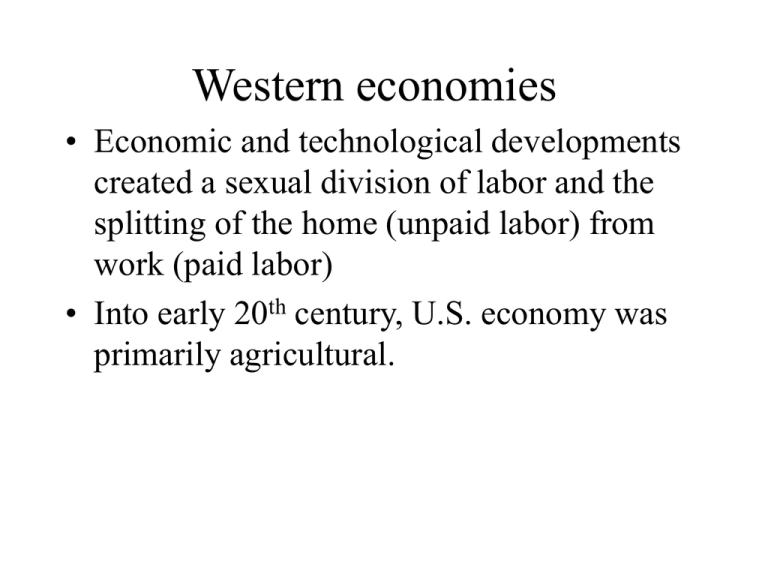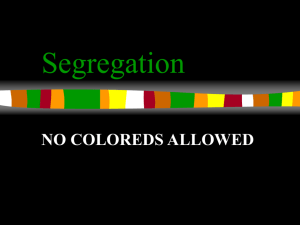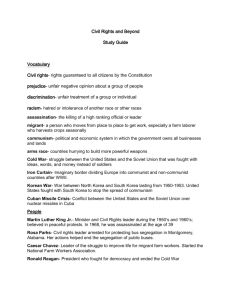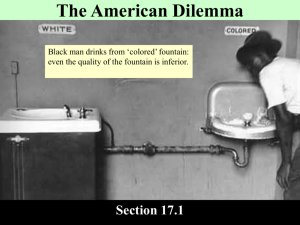VIII. History
advertisement

Western economies • Economic and technological developments created a sexual division of labor and the splitting of the home (unpaid labor) from work (paid labor) • Into early 20th century, U.S. economy was primarily agricultural. Changes to Family Economies • Family economy: wives, husbands, and children worked on farms and in households to contribute to the family. • Rise of Industrialization: the rise of factories changed the family economy making it a family wage economy or a family employment system where fathers worked in factories and paid wives, children, relatives. • Development of technology created factories to produce what once had been produced in the home by hand: sewing machines instead of hand sewing, knitting machines instead of hand knitting, etc. The Splitting • With goods production moved out of home into industries, the products of paid labor began to be more culturally valued than the products of home labor. • Geographic separation developed between home and work severing interdependence of work and family. • Urbanization (development of cities) integrated more new European immigrants • Family maintained values of interdependence with industrial workers supporting families (“mill girls” gave money to family until immigrants took these jobs) Different Histories • Economic development affected cultural groups differently (see Hoffert): – African-American class development and family experiences different because of institution of slavery where workers were not paid, and families were broken up in South, freed people in North – Native American experiences of reservations and geographic/economic dislocations affected relationship to industrialization. U.S. government negotiated with Native American men not women undercutting women’s power. – Immigrant experiences differed depending on when people came to U.S. and from where: Jews came to be shop keepers; Irish/Finnish women first came as maids through agencies for middle/upper class English, immigrant men as miners (Finnish Minnesota Iron Range, Italian Kentucky mines), Chinese men indentured servants/rail workers on west coast. Immigrant working classes experienced economic and family differences—brought their cultures with them. Rise of Middle Class • Greater prosperity resulting from industrialization led to development of middle class professionals and managers • Middle class split roles: men became worker and family breadwinner, women became family mother and homemaker. • Role of social institutions (employers, government, labor unions, law) in institutionalizing this split. Laws created “protective legislation” keeping women out of some jobs. • These splits became “normative” set up ideal of family life for everyone including working classes: white factory worker men organized in trade unions that kept women and minority men out and got a “family wage” to support entire family Doctrine of Separate Spheres • Institutionalization of family/work splits in 19th century gave rise to a doctrine of separate spheres • Work sphere associated with values good for development of capitalist markets: competition, rationality, achievement, independence, individualism. Values associated with masculinity. • Home sphere associated with values of domesticity, purity/piety, submissiveness/dependence, love/emotions, harmony, spiritual values—home as ”haven from heartless world” of work. Values associated with femininity. In 1890, less than 5% of married women were measured in paid employment. Normative Ideals • “Real” men were “self-made men” in the “good provider role” of breadwinners (Kimmel, Manhood in America—”the making of the self-made man” 1776-1865) • “Real” women were saintly mothers and good housekeepers, always happy and managing family emotions by creating culture of harmony and care (Cott, Bonds of Womanhood—”cult of domesticity/true womanhood 1780-1835) • Deviants from ideals were not “true” men or women. Examples? Dislocations to threaten ideal: War • Wars brought women into the labor market in different capacities from previous generations. • Crimean War: British Florence Nightingale started nursing with women as nurses—unheard of before that to find women in active war role (unless in drag) • World War II: Rosie the Riveter—a character made up to demonstrate how women could/should take on industrial jobs left by men who went to war. Of industrial jobs, one out of ten (600,000) were African American. • Milkman: all work became women’s work Post WWII Women in Labor Force • With returning WWII male veterans, the Rosies were kicked out of their jobs and govt. propaganda put them back in the home making babies. • 1950s-1960s economically strong, gender ideals of Leave It to Beaver family strong. • Challenges: Vietnam War, oil crises early 1970s, around 1977 male wages begin to decline. Late 1970s to early 1990s male wages declined more than women’s earnings. This factor pushed married women into labor market to make up lost family wages. Dislocations: Divorce • Rising divorce rates: from 1960s to peak in 1980, stabilized, slight decline. Necessitates women working. • Research shows that marital instability may be the cause or the result of women’s economic independence. Costs of staying home and rewards of working for pay greater today than 1970s. Late th 20 century Social Changes • Progressive legislation Legal barriers breaking down with Equal Pay Act 1963; Title VII of Civil Rights Act 1964 • Second wave women’s movement emphasis on economic independence and equal opportunities • 1972 Education Amendments and legal challenges to increase women’s education: in 1971 18% of twenties’ women had college degrees, in 1998 29% did. • Education and job opportunities for women rising. • Economic development where economy moved from producing goods to producing services and information. In 2001, half of all working women were employed in service sector and clerical jobs. • Heterosexual married couples with children make up ¼ of all households today. (1960—40%); 1/3 married w/out kids; 1/3 single parent (18%--86% female head), living alone, or cohabiting. 1/3 all births to women over 30. Labor Force Today • 47% employed workers are women; 53% men. • Majority of both sexes work for pay full time. • 55% of women with kids work (60% African-American women; 53.4% Latinas; 60% Asian American, 59.1% white) Sex Segregation • Concentration of women and men in different occupations, firms, jobs • Occupational sex segregation refers to concentration of women/men in different occupations. • Sex segregation at job level more extensive than at occupation level. • Voluntary organizations also segregated Index of Dissimilarity • Measure of segregation: index of dissimilarity (100=complete segregation; 0=complete integration) • Level of sex segregation approximately 51.5% in 1990. • Means that more than half of either sex would have to move to another occupation to bring about integration. Race/Ethnic Segregation • Most studies focus on African-Americans and whites • Levels of occupational segregation by race lower than by sex. • Women/men more likely to work in different occupations than blacks/whites • Sex segregation among blacks/whites greater (60) than racial segregation among women and among men (30 late 1980s) Occupational Sex Segregation • A feature of all industrial societies. Segregation greater in countries with large service sectors, lower where low birth rates and stronger egalitarian belief systems (Scandinavia) • Declined in 1970s • Women moved into occupations previously held by men (librarian, clerical, teacher, bank teller) during early 20th century, later moved into public relations, systems analysis, bartending, advertising, insurance, veterinary medicine (doubled since 1991, men declined by 15%) • Only three occupations where men increased: cooks, kitchen workers, maids/housemen. • Interventionist or non-interventionist government (equal opportunity legislation, family benefits, state-subsidized child care/family leave) define sex segregation regimes (Chang in Wharton). Time Bind • Increasing demands from work and family create a time bind—not enough for either (Hochschild) • Men happier going from work to home, women going from home to work (constraints vs. freedom experienced emotionally) Comparative Examples Early 2000. • Sweden: extensive govt. involvement (paid parental leave 80%; maternity/paternity leave; public childcare) • Netherlands: breadwinner model; women part-time work (60% of working women); paid maternity leave; limited public childcare (17% under four) • Italy: private solutions—traditional family and grandparents; paid maternity leave; limited public childcare (6% under three) • United Kingdom: paid maternity leave; minimal public childcare (kids “in need”) • European Union Agreements means some change References • Wharton, Chapter 4 • Sylvia Hoffert, A History of Gender in America: Essays, Documents, Articles (2003) • Nancy F. Cott, The Bonds of Womanhood (1977) also histories of women in America. • Michael Kimmel, Manhood In America (1996)





